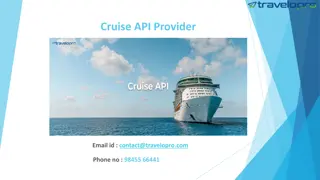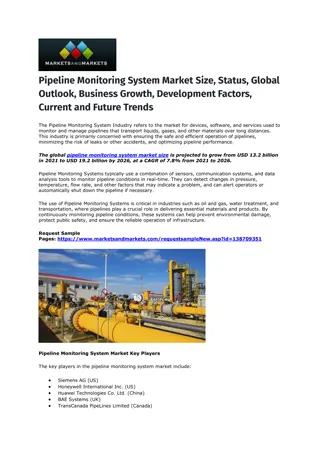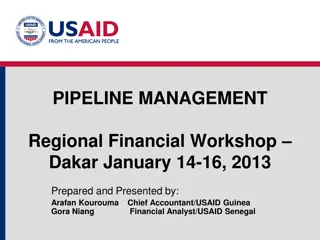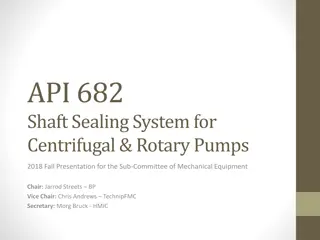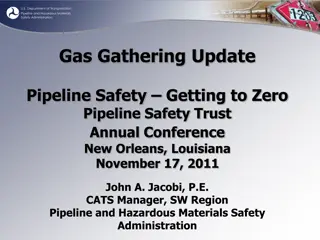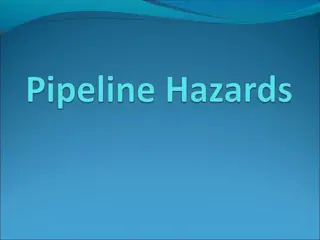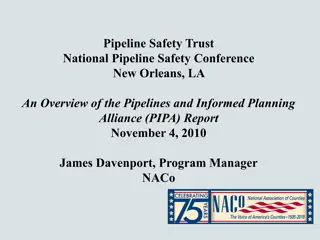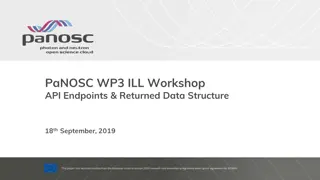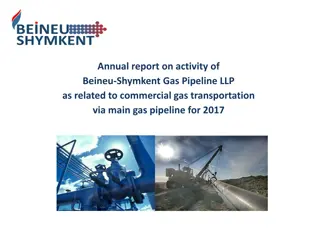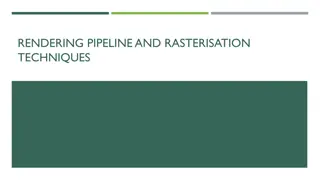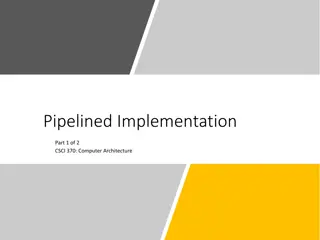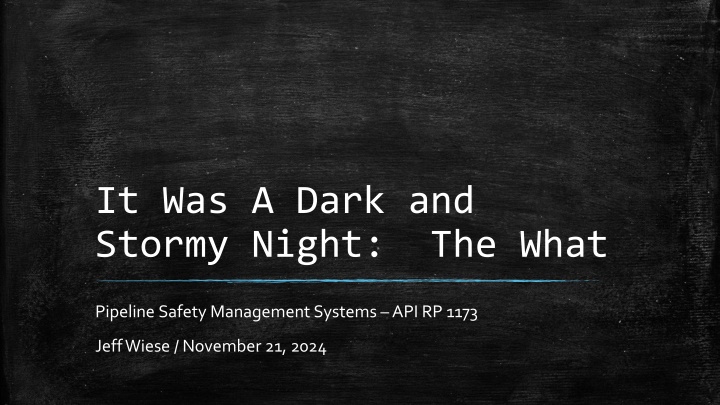
Pipeline Safety Management Systems: API RP 1173 Origins & Evolution
The history and significance of API RP 1173, its development, and the impact on pipeline safety management systems. Explore the journey from industry accidents to the creation of a new standard by API.
Download Presentation

Please find below an Image/Link to download the presentation.
The content on the website is provided AS IS for your information and personal use only. It may not be sold, licensed, or shared on other websites without obtaining consent from the author. If you encounter any issues during the download, it is possible that the publisher has removed the file from their server.
You are allowed to download the files provided on this website for personal or commercial use, subject to the condition that they are used lawfully. All files are the property of their respective owners.
The content on the website is provided AS IS for your information and personal use only. It may not be sold, licensed, or shared on other websites without obtaining consent from the author.
E N D
Presentation Transcript
It Was A Dark and Stormy Night: The What Pipeline Safety Management Systems API RP 1173 Jeff Wiese / November 21, 2024
My Topic and Objectives Introduce Myself Explain that Obtuse Title / Recent History Add Context to the Origins of API s RP 1173 Who Developed RP 1173 Why Focus on Management Systems What Is Pipeline SMS A Few PSMS FAQ s Punch Lines Segue to Steve Allen of EWN (more on the how)
Personal History Immersion in Regulatory and Risk Management 35+ year career in energy First half in US DOI s Minerals Management Service Member of the original RP 75 which became the Safety and Environmental Management Systems regulatory requirement post Deepwater Horizon Second half at US DOT s Pipeline and Hazardous Materials Safety Administration Ran it s Congressionally Directed Risk Management Demonstration Program + Program Development 10 years as the head of PHMSA s Office of Pipeline Safety where, among many other things, I: Served as the Executive Director for 2 Advisory Boards (Liquid/Gas) with 15 members each Orchestrated an Interagency Risk Management Working Group: DOT, DOI, DOE, NTSB, NRC + Previous Board member for the Common Ground Alliance (4 years) Center for Offshore Safety (2 years) A major utility company (4 years) SVP for TRC Companies (6 years) Currently an independent consultant as well as an ssessorfor API s PSMS program
Obtuse Title / Recent History Pipeline industry record is relatively good given its enormity and criticality, but it is clearly a high hazard industry low probability/high consequences A significant accident nearly every day, resulting in 11 fatalities , 51 serious injuries, and over a half billion dollars of property damage/loss each year (most recent 10 year averages) next slides Particularly serious pipeline accidents in 2010 and 2011 investigated by NTSB revealed management system weaknesses as major contributing factors. Following its investigation of the Marshall, MI accident among other things: NTSB recommended that a Pipeline Safety Management System would improve performance through top management leadership and gave that charge to API. API assembled a diverse group of industry, government, and public stakeholders to build the PSMS over the course of two years When completed, NTSB issued an exceeds expectations review of API RP 1173, saying it set a new standard for high hazard industries
Participants in the Development PSMS Ron McClain, Kinder Morgan (ret.), Chair Robert Miller, AZ Corporation Commission (ret.) Scott Collier, Buckeye Partners (ret.) Massoud Tahamtani, VA State CC (now PHMSA) Tom Jensen , Explorer Pipeline Bob Beaton, NTSB (Ex Officio) Paul Eberth, Enbridge Pipelines Kate Miller, AGA (ret.) Brianne Metzger-Doran, (formerly Enbridge, now TC) John Ericson APGA (ret.) Tracey Scott, (formerly Alliance Pipeline) Scott Currier, INGAA (TC Energy/ INGAA) William Moody, Southwest Gas (ret.) Peter Lidiak, API (ret.) Nick Stavropoulos, Pacific Gas and Electric (ret.) Mark Hereth, P-PIC, Content Editor Steve Prue, Small Gas Distribution (ret.) 4 Liquids Pipelines 4 Natural Gas Pipelines 1 City Distribution 4 Trade Organizations 4 Regulators 2-PHMSA 2-NAPSR 1 NTSB 3 Public SME s 1 Contract Engineering 1 Standards Organization Stacey Gerard, Public SME and consultant Jeff Wiese, PHMSA (now independent) Linda Daugherty, PHMSA
Why Focus on Management Systems? All parties seek a significant reduction in pipeline failures and gas/oil leaks America is critically dependent on energy delivered by these pipelines and will be for some time to come at least until renewables can replace it without massive disruptions The social license to operate and grow is clearly at risk and the cost of failure is rising Most high hazard industries, where low probability/high consequence events in operations create unacceptable consequences, already made the choice, or it was made for them, to adopt a management systems approach Aviation, nuclear, chemical, petroleum refining, medical, food safety industries: https://www.youtube.com/watch?v=uFGvpY22jgg&list=PL4wHDsuQ-uKm7Mz20uvkeagVu2u_Cro6o They recognized that it is not practical to envision and develop procedures for all possible adverse events, and that we live in a constant state of change There is a rapidly growing realization about the critical role that culture and employee engagement play in highly reliable organizations
Now The What: SMS Elements 1. Leadership and Management Commitment 2. Stakeholder Engagement 3. Risk Management 4. Operational Controls 5. Incident Investigation, Evaluation, and Lessons Learned 6. Safety Assurance 7. Management Review and Continuous Improvement 8. Emergency Preparedness and Response 9. Competence, Awareness, and Training 10. Documentation and Record Keeping All Steeped in A Safety Culture Built Around a Focus on Learning and Continuous Improvement
Path to Zero: Commitment,Learning, Continuous Improvement, and Culture 10
Things People Commonly Ask About The Why Is this just another flavor of the day and will operators be forced to do this (by regulators or others)? Most regulators adopting a watchful waiting approach, and some are experimenting collaboratively. Reported on progress to Congress in 2024. In a few cases serious infractions may lead to stronger encouragement We are relatively small. Will this apply to all operators? Pipeline SMS is VERY scalable PSMS will bring a regular, formal structure and strategic approach to safety, and a good gap analysis may well show that even small companies are already doing many of the elements of a fully-developed PSMS Those new to SMS will benefit from learning how formally to measure, track and improve their safety performance My bet - not only will PSMS improve safety but it will make money! Why do we have to think about all that soft, cultural stuff? Culture eats strategy for breakfast every day It s the oil in your SMS engine 11
Punch Lines RP 1173 remains voluntary for now; Congress is alert to PSMS RP 1173 has been reaffirmed thru 2027, but API target to publish Rev. 2 is 2025, and the large work team is nearing completion of a draft All major operator and contractor trade associations and regulators are actively advocating conformance to RP 1173, and most are actively trying to help. For a good start see: http://www.pipelinesms.org/ The major pipeline trade associations are assessing member progress through surveys and are sharing lessons learned Implementation surveys are underway and results are published on PipelineSMS.org Broadly speaking larger operators are underway though smaller operators are lagging behind 12
Contact Information: Jeff Wiese Jeff.Wiese@gmail.com 703.787.6644 (cell)


